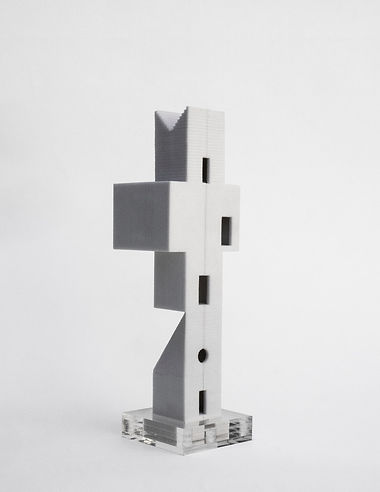TIME-BASED MEDIA ART MUSEUM IN BERLIN
FIGURATION, AWKARDNESS
Architecture for museums has achieved such a level of sophistication and precision than one could say that the challenge for a novel museum—even one for time-based media— fundamentally is not to be found in the architecture, but instead on the management of the museum as an institution.
This project is not interested in demagoguery and all-too-easy answers ready to behead the Museum and its Architecture. The fact remains that a majority of time-based art pieces—old and new—demands extremely sophisticated and controlled displays. This project is interested in providing a frame for an appropriate experience of art, while simultaneously taking the chance to inquire figuration and awkwardness as broader topics within the discipline.


SITE—The site is in a vibrant and dynamic part of Berlin, just next to the central train station and within proximity to the Reichstag. It features two distinctive sides. On the north, the street is dynamic with the continuous flow of vehicles, trams and pedestrians. To the south, the presence of a large body of water provides calm views highlighted by the trains that cross a bridge at a distance.
The project is organized through eight totems that change in size and shape as they progress vertically to accommodate different spatial and programmatic opportunities.

The ground floor develops around the base of the totems. Functionally, a portion of it is intended to operate as a public plaza for the local community with the potential to become a collaborative place for the production and dissemination of time-based art. The other portion of the ground floor constitutes the museum entrance leading to the collection and exhibition spaces on the levels above and below. Both zones conform a visually unified public realm and are physically connected through a shared auditorium and one of the totems.

The museum´s formal and aesthetic ethos is predicated on a different sensibility, one that simultaneously absorbs the normal, the archaic even the awkward; like much of our digital culture and time-based art pieces.



L3

L2
L1

Various kinds of exhibition spaces are distributed throughout all levels, from the basement to the roof. The main galleries are located on the second and third floor. The second level is a functional black box with exhibition space around the totems that can be subdivided with temporary walls as needed. On this level, some of the totems exist as smaller anchor rooms that provide an opportunity for the display of core pieces as well as for more personal interaction with the art.
The totems also connect various levels visually either above or below. The third level of exhibition space expresses a more refined permanent character with two conditions for displaying art. On the one hand a continuous space in between totems flooded with the daylight and visually connected to the city, on the other hand, and interior galleries within the expanded volumes of the totems.

The access to the museum is through one the totems. Upon entry, the visitor is confronted with a mechanical walk that will provide a cinematic perception of the city and the public plaza. As one travels through the mechanical walk—in time—, so does the glimpses into the public plaza and the museum in between the totems.


HIGH & LOW CULTURE—The project seeks the synthesis of high and low culture and embraces complexity and contradiction. It explores the unbound intellectual and aesthetic territory of figuration, awkwardness, and twisted beauty.
White-concrete totems conjure the archaic, the heroic and high culture. The required sophisticated craft for the correct execution of the complex forms and finish work supports this ambition. Linear formwork marks are left visible in the most exposed parts of the totems—roof and public plaza—This texture provides a sense of strata, rustication and matches the stepped-profile that results from contouring the initial forms. The iconic character of the heads meets the digital by a low-resolution image—profile—of concrete formwork.
A corrugated aluminum facade wraps around the upper exhibition spaces. Hide and seek: this is not a didactic building. Cut and folded aluminum sheets, and flushed and open joins: the aluminum facade appeals to the low-culture and industrial imageries. Its expected changeable appearance under variable light conditions reaffirms the permanent and heroic presence of the totems.


LOCATION
Berlin
PROGRAM
Museum
Date
2019
TEAM
Francisco Ramos